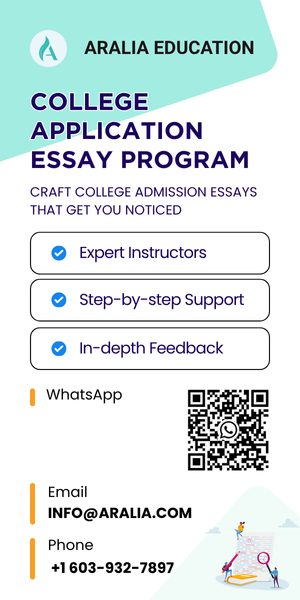85% of Aralia Students Place in Top Writing Competitions
1. What is an Abstract?
In short, an abstract is a 150 to 250-word summary of your science research paper. Readers will skim your abstract before deciding to read your full paper, hence the abstract should overview the research topic’s purpose, methods and materials, significance of main findings, and conclude with the applicability of findings and a general suggestion for future research. For your high school science research paper, your abstract should condense the core elements of your paper into a single, easily skimmable paragraph. This blog will cover essential components to writing a strong abstract.
2. What to Include in an Abstract for a High School Research Paper
Research Question and Hypothesis
If your research paper is about an experiment you conducted, answer the questions: “What was the point of your experiment? What did you expect to find?” Suppose your research paper is a meta-analysis of published research studying the mental health effects of extensive (2+ hours per day) social media usage on adolescent girls. Your abstract should include this research topic and clearly state that your paper is a synthesis of important findings from multiple independent studies. Note: a meta-analysis research paper will not need a hypothesis.
Experimental Procedure
Continuing with the above example of a meta-analysis of published research, what criteria did you use to decide if a research article could be included in your meta-analysis? For example, say you only looked for studies published between 2015-2025 and that did a mental health screening of participants using the Generalized Anxiety Disorder 7-item (GAD-7). It’s important to name that questionnaire and the publishing years in your abstract so readers understand the scope of your research paper.
Participant Demographics and Sample Size
If your research paper is about an experiment, answer the questions: “How did you choose your sample pool? Who were your participants, and how many did you have?” This helps readers identify whether your research would be applicable to them. For example, your participants were all high school-aged females living in New York City, but your reader is looking for research information on college-aged females living in San Francisco. Your abstract would help readers easily identify that your research paper is not what they’re looking for; likewise, it will attract readers looking for information on people in that specific demographic.
Research Findings
Detail the extent to which your hypothesis was proven right or wrong. Instead of simply writing, “Yes, my hypothesis was proven correct,” you should explain how certain findings supported your hypothesis while other findings led to neutral or opposing results. For example, maybe your research found that spending multiple hours on Instagram and TikTok had negative mental health effects on adolescent girls, while Facebook/Meta and LinkedIn didn’t yield significant effects.
Future Research Direction
In one sentence, mention a question your research couldn’t answer and suggest a new research direction or study for other scientists to complete. This should be a summary of your conclusion paragraph in your paper. Use your conclusion to discuss mistakes made, explanations for unpredicted results, pointers for improved replication studies, opportunities for future research, and new questions that arise from completing your research experiment. Use your abstract to summarize your conclusion.
Keywords
After your abstract, on a new line, list around five keywords to aid search engine optimization, allowing readers to easily find your research paper and quickly understand the scientific concepts your research tackles. For example, keywords for the above examples could be meta-analysis, review, social media, mental health, adolescence, anxiety, screen time, and/or digital technology use.
3. Tips for Writing an Abstract
Write your abstract last, particularly after you’ve finished writing your introduction and discussion sections. Your introduction explains your research topic, clarifies the necessity for furthering research in this area, and defines important terms to specify your research scope. Your discussion analyzes the meaning behind and significance (or not) of the data results you collected. These two sections are the crux of your abstract, so it’ll be easier to write your abstract after you’ve polished those sections.
After you’ve completed your research paper. Write a two-sentence summary for each section: Introduction, Methods and Materials, Results, Discussion and Conclusion. Combine these summaries into a paragraph
4. Four Examples of Abstracts: Analyzing the Good and Bad
Example 1: Abstract of a Review Paper
“This paper explored how using many social media platforms on a regular basis affects the user’s anxiety and stress. With a worldwide average that each person owns 8.8 social media accounts in 2020, the topic of social media multitasking is an exceedingly prevalent area for research. First, this paper discussed how this behavior predicted symptoms of depression and anxiety. Next, the topic funneled in to examine youth as the most at-risk subgroup for these negative effects. Lastly, to obtain a wide and thorough perspective on this topic, the third section discussed studies with contradictory conclusions; some types of social media multitasking behavior have neutral or even beneficial effects, but only for select individuals. It is not a far stretch to say that everyone with internet access uses more than one social media platform as a necessity in their daily lives. Therefore, it would be helpful for future research in the counseling field to focus on finding effective solutions to the negative effects of social media multitasking.
Keywords: social media, multitasking, anxiety, stress, depression, youth“
Good: Clear structure detailing the three subsections of the paper. Tackles contradicting viewpoints for a stronger narrative. Recommendation for future research and applicability of the research field.
Bad: Lacks specific findings, particularly for subsection three: what beneficial effects and which select individuals? Lacks methods section: how was the research conducted?
Example 2: Abstract of a Meta-analysis Paper
“This paper examines how brain activity, specifically theta waves detected by the neuroimaging technique Electroencephalography (EEG), can help predict consumer behavior. Traditional marketing methods, like surveys and focus groups, often fail to capture the subconscious factors that influence decisions. Neuromarketing offers a solution by analyzing brain activity to understand what drives consumer preferences. This paper reviews multiple studies that utilized EEG to create maps of different brain waves and accurately predicted whether a consumer likes or dislikes a product. EEG is proven to be an affordable, portable, and effective tool with potential for improving marketing campaigns. While challenges like small sample sizes and inconsistent testing conditions remain, the findings demonstrate the potential of neuromarketing to improve marketing strategies and reduce product failures. These research findings open possibilities for businesses to adopt EEG technology to create more effective and consumer-focused campaigns.”
Good: Reader-friendly definition of the complex topic of neuromarketing and neuroimaging techniques. Organized structure that summarizes each section of the paper.
Bad: Lacks information on the number of studies reviewed for this meta-analysis, how these studies were selected, and the variables tested in the studies. Failed to highlight the crucial link between the reviewed studies: that theta waves are linked to decision-making.
Example 3: Abstract of a Replication Study Paper
“Social norms are very effective in motivating the public to modify their behaviors. Plentiful research support that participants conform to the popular norm when comparing themselves to a static norm—a social norm that describes the current state of public behavior. What about the effects of conformity when testing with a dynamic social norm—a social norm that describes the public’s change over time? Sparkman and Walton’s (2017) studies found that dynamic norms have a stronger effect on promoting sustainable behavior than do static norms. Our replication of their study seeks to find the same conclusion with a sample pool of 395 participants via an online survey. Most participants were undergraduate psychology students at Tufts University. We hypothesized that a dynamic norm describing decreased meat consumption efforts (vs. a static norm) will more heavily influence participants to reduce their meat consumption. However, our results show that the effect size is negligible, and we are unable to reject the null hypothesis. This replication of Sparkman and Walton (2017) yields contrasting results from the original study. Several reasons for these results stem from the limitations of our replication study. Due to poor validity problems—such as our unrepresentative and very skewed sample size and weak manipulation between the norm conditions—further replication research is necessary to confirm Sparkman and Walton’s findings.
Keywords: social norms, sustainability, social influences, motivation”
Good: Clearly states the purpose, hypothesis, and structure of the experiment, as well as participant demographics. Defines crucial terms such as “static norm” and “dynamic social norm.”
Bad: Lacks information on the Sparkman and Walton (2017) study that this experiment is replicating. Confusing jargon with “weak manipulation between the norm conditions,” where more information on the issue would be helpful.
Example 4: Abstract of an Experiment Paper
“In this study, college students interacted 1:1 with a EV3 Puppy robot by petting and feeding the robot dog. This robot dog, named Grootie, was designed to provide emotional support for college students while they are under pressure and stressed with finals. Feng and Ha predicted that participants would feel a decrease in stress levels, indicating an improvement in mood, as well as an overall more positive attitude towards robots after interacting with Grootie.”
Good: Clearly identifies the research question, purpose, and hypothesis.
Bad: Lacks results and discussion. The abstract should state that the results supported the hypothesis but were statistically insignificant. Lacks details on participant pool: how many college students were tested and which gender, nationality, age, etc. were they?
Unlock Your Writing Potential: Students in Our Writing Competition Preparation Class Are More Likely to Secure Awards
5. Common Mistakes to Avoid
Exceeding the 250-word limit.
Do not make your abstract too long. An abstract exists to serve as an easy-to-skim, quick summary for readers to decide if the paper is relevant to their interests. If your abstract is too long, your reader may not want to read it and therefore not read your paper. Also, make sure your abstract is only one paragraph.
Understating statistically significant findings.
Your abstract is not an introduction; it is a summary. The second half of your abstract should be dedicated to highlighting the most important results and discussion points of your research. Do not blur your abstract with too much detail on the details of how you conducted your experiment—keep it concise and focus on the statistically significant findings.
Leaving complex jargon unexplained.
Remember, not every reader is an expert in your field of research; they’re reading your research paper to gain knowledge. Avoid adding terms that only experts would know. If a technical term is necessary to mention in your abstract, define it. For example, the time-displacement hypothesis is a complex term that you should define as the theory that time spent on social media replaces time on healthier activities such as face-to-face social interactions and team sports. Often, the strict word limit on an abstract prevents you from defining terms, so consider leaving out complex jargon entirely.
Introducing new information.
Your abstract is not a conclusion either. Do not end your abstract with a new, curious perspective. If you didn’t mention something in your conclusion, it should not be in your abstract.
6. Conduct research with Aralia Education
Take your research skills to the next level with engaging, rigorous, and rewarding classes at Aralia Education. We pair students with carefully vetted teachers from top private high schools across the U.S. Explore our extensive range of research programs, including psychology, history, international relations, business, economics, and AP Seminar—where you can choose any subject area to research. Join an Aralia class to work on real-world projects, learn advanced research methodologies, and work with experienced teachers to publish in high school research journals!









